Menu
Physics Lesson 6.9.2 - Examples of torque involving forces
Please provide a rating, it takes seconds and helps us to keep this resource free for all to use
Welcome to our Physics lesson on Examples of torque involving forces, this is the second lesson of our suite of physics lessons covering the topic of Torque, you can find links to the other lessons within this tutorial and access additional physics learning resources below this lesson.
Examples of torque involving forces
- Rotating the steering wheel of a car,
- Rotating the handle bar of a bike,
- Two men rotating a grinding mill, etc.
Other examples of torque but which involve the use of a single force include:
- Pushing a door as it swings on its hinges when pushed,
- Turning the key,
- Turning the dood knob, etc.
As you can see, all three examples shown above (in the second set of examples), involve the same process: opening a door. Thus, torque is applied three times in a row in this process: turning the key (action 1), turning the door knob (2) and pushing the door as it swings around its hinges (3). Look at the figure.
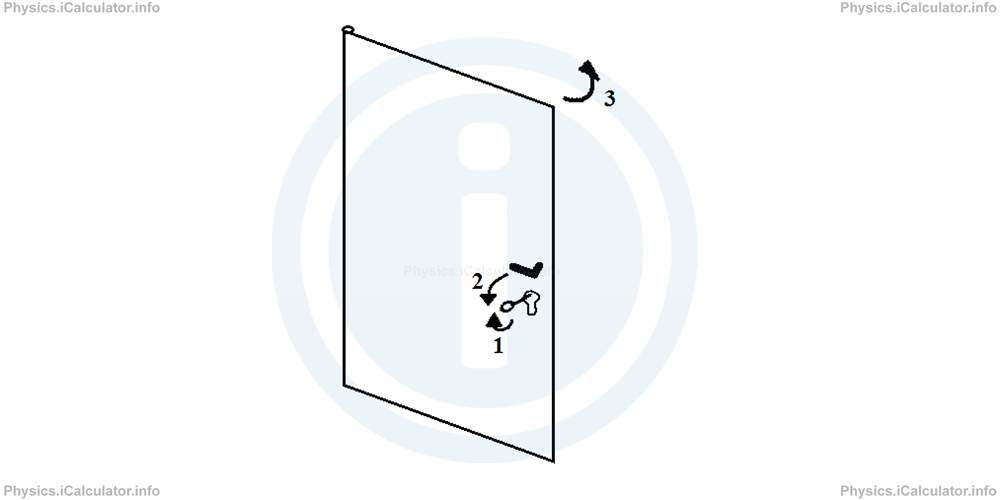
On the other hand, in the first set of the abovementioned examples, there are two forces acting in the same direction or rotation on both sides of a system. Let's take the steering wheel for illustration.
Both forces applied by our hands help each other making the rotation of steering wheel easier. As a result, the car turns in the desired direction. In the figure below, forces F1 and F2 help each other rotate the steering wheel clockwise. As a result, the car turns right.
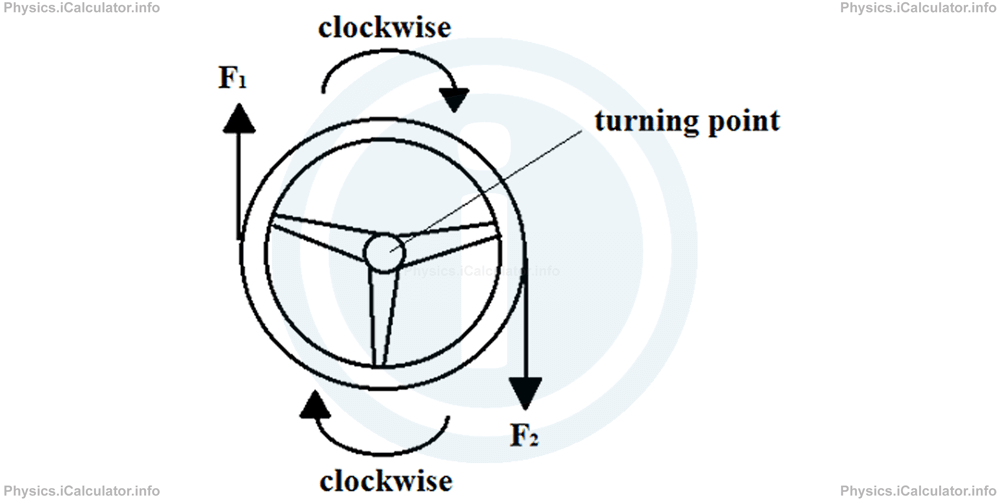
In most cases (although it is not a must), the distance from the turning force is the same for each force applied when they form a couple. This helps the users balance their senses. In the specific case, this distance is equal to the radius of the steering wheel.
Both Moment of Force and Torque have the same unit i.e. N-m but The equation of torque for a single force applied is:
where r ⃗ is the distance from the turning point (usually the radius of a circle), and F⃗⊥ is the perpendicular force to the bar (line of action) or the tangent force used at that specific point of the circle.
The scalar equivalent of the above equation is
where θ is the angle between the axis of rotation and the force applied. Look at the figure:
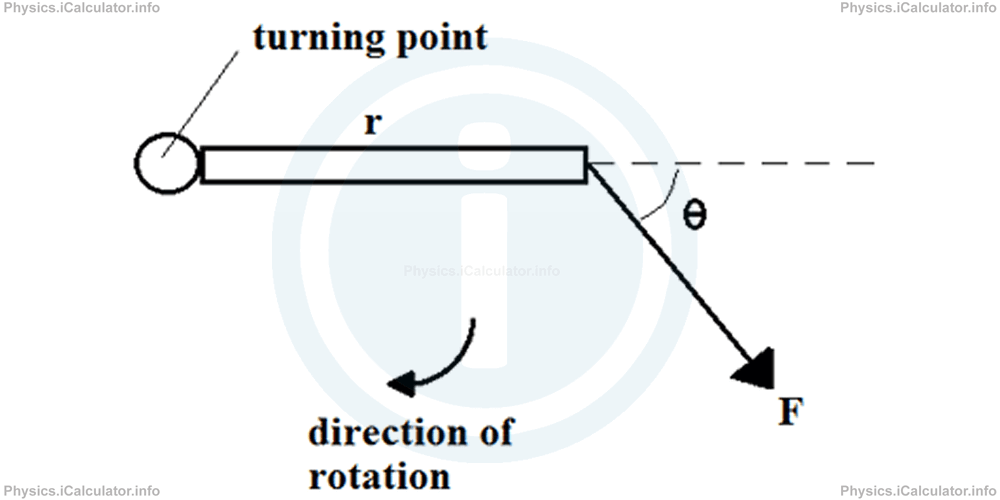
In this figure there is a single force that produce torque. However, not all the force goes for the rotation of the system; some of it is wasted (the component of force in the direction of the bar). Therefore, since only the component of force perpendicular to the bar is able to produce rotation, we consider only it as a turning force.
Example 1
A 60 N acts at the edge of a bar in the direction shown in the figure.
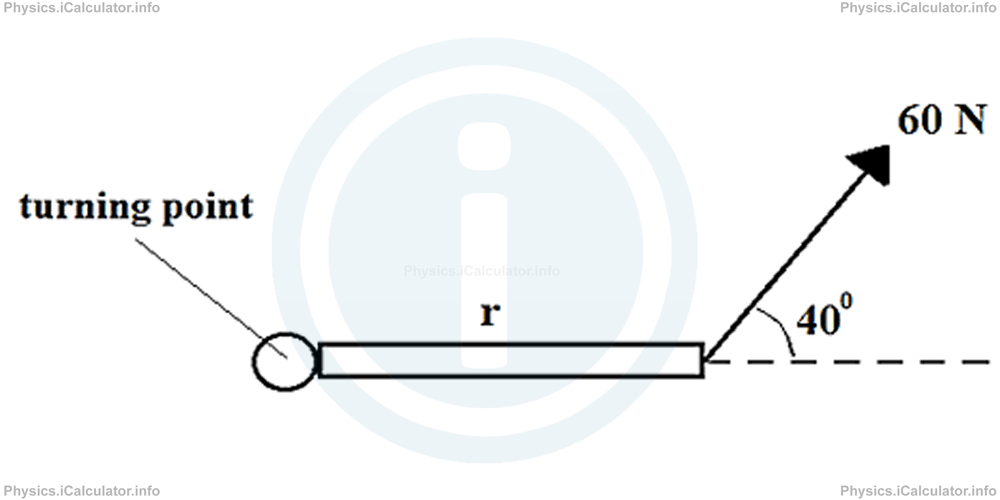
Giving that cos 400 = 0.766 and sin 400 = 0.643, calculate the length of bar in cm to produce a 10 N × m torque.
Solution 1
From the scalar equivalent of the equation of torque
we obtain after substitutions,
10 = |r| × 38.58
|r| = 10/38.58
= 0.2592 m
= 25.92 cm
≈ 26 cm
As for the torque of a couple, we obtain the following equation:
When the couple of forces is used to rotate a kind of wheel (such as a steering wheel), we have
= r2
= r
Example 2
A steering wheel has not been lubricated properly and a 12 N force is needed to overcome friction. What is the minimum force a driver must use on the steering wheel with either hand to make the car turn left at 24 N × m? The diameter of steering wheel is 36 cm.
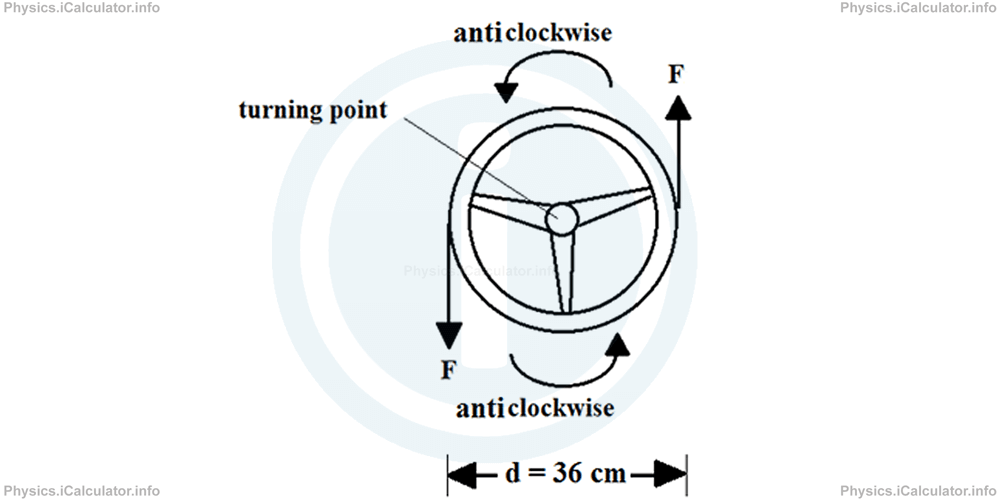
Solution 2
The steering wheel must rotate anticlockwise to make the car turn left. Also, F1 = F2 = F and r1 = r2 = r = d/2 = 36 cm / 2 = 18 cm = 0.18 m.
The torque given in the clues is the resultant (net) torque. It inludes the positive torque produced by the driver and the negative torque of the friction against motion. Therefore, we have
For the negative torque produced by friction, we have
If we take the angle θ = 90° (as we need the minimum values of force), we obtain
= -2.16 N × m
Therefore, the torque produced by the driver is
τ ⃗driver = 24 N × m + 2.16 N × m
= 26.16 N × m
This torque is produced by a couple of equal forces acting at r = 0.18 cm away from the turning point. Thus, we have
= r ⃗ × F ⃗ + r ⃗ × F ⃗
= 2r ⃗ × F ⃗
= 26.16 N × m
Thus,
0.36 × F ⃗ = 26.16
F ⃗ = 26.16/0.36
= 72.7 N
Therefore, the driver must apply a 72.7 N by either hand to make the system rotate as described.
Remark! As for the signs of the directions of rotation, anticlockwise is taken as positive [clockwise is negative].
You have reached the end of Physics lesson 6.9.2 Examples of torque involving forces. There are 2 lessons in this physics tutorial covering Torque, you can access all the lessons from this tutorial below.
More Torque Lessons and Learning Resources
Whats next?
Enjoy the "Examples of torque involving forces" physics lesson? People who liked the "Torque lesson found the following resources useful:
- Example Feedback. Helps other - Leave a rating for this example (see below)
- Centre of Mass and Linear Momentum Physics tutorial: Torque. Read the Torque physics tutorial and build your physics knowledge of Centre of Mass and Linear Momentum
- Centre of Mass and Linear Momentum Revision Notes: Torque. Print the notes so you can revise the key points covered in the physics tutorial for Torque
- Centre of Mass and Linear Momentum Practice Questions: Torque. Test and improve your knowledge of Torque with example questins and answers
- Check your calculations for Centre of Mass and Linear Momentum questions with our excellent Centre of Mass and Linear Momentum calculators which contain full equations and calculations clearly displayed line by line. See the Centre of Mass and Linear Momentum Calculators by iCalculator™ below.
- Continuing learning centre of mass and linear momentum - read our next physics tutorial: Centre of Mass. Types of Equilibrium
Help others Learning Physics just like you
Please provide a rating, it takes seconds and helps us to keep this resource free for all to use
We hope you found this Physics lesson "Torque" useful. If you did it would be great if you could spare the time to rate this physics lesson (simply click on the number of stars that match your assessment of this physics learning aide) and/or share on social media, this helps us identify popular tutorials and calculators and expand our free learning resources to support our users around the world have free access to expand their knowledge of physics and other disciplines.